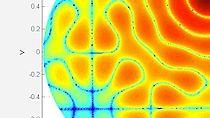Radar System Modeling and Simulation for Automotive Advanced Driver Assistance Systems
Automotive Advanced Driver Assistance Systems (ADAS) continue to expand in scope with every new model year. Through a combination of legislation and consumer demand, vehicle safety continues to migrate to the forefront of system designs. There are a wide range of sensors that can be used to help make a vehicle safer by improving the “awareness” of what is on the road. By implementing systems that are sensor based, the level of safety can be greatly enhanced by passive and active methods within a vehicle.
Sensor technology effectively adds to the number of “eyes” on the road. One of the components of ADAS sensor technology is based on radar, which has the advantage of being able to see when it is dark or foggy. Radar also provides the ability to measure speed and distance of objects and ADAS solutions will quickly evolve to take advantage of radar beamforming and imaging.
In this session, we will demonstrate techniques for modeling and simulating radar-based ADAS systems. We will include the radar transmitter and receiver, the radar signal processing algorithms, speed control, and 3D animation. We will also show you how you can model nonlinearities and noise effects at the radar component level, which will also allow you to analyze performance and explore parameters of the system components.
MathWorks engineers will demonstrate how MATLAB, Simulink and the Phased Array System Toolbox can help you design your radar systems, while allowing you to rapidly try different configurations. You will see how you can integrate earlier at the system-level. We will also demonstrate how models of systems can be assembled in short order and how they can then be quickly modified to map to each phase of your project workflow.
Through an example of a Long Range Radar system in a complete Adaptive Cruise Control (ACC) system and a Short Range Radar system for Blind Spot Detection, you will learn how to use MATLAB, Simulink, Phased Array System Toolbox and RF Blockset to:
- Model and simulate automotive radar systems, explore alternative system architectures and make system level trade-offs
- Use a waveform generator to design and generate FMCW and MFSK waveforms
- Integrate signal processing algorithms to determine speed and range of multiple objects
- Increase system fidelity through models of RF receivers using RF components and network parameter measurements
- Create closed loop system simulations with radar system, speed control algorithms, environment model, and 3D visualization.
Recorded: 25 Aug 2015




